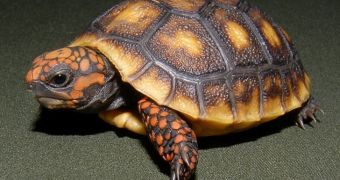Scientists might still be a long way from figuring out whether it's true that you can't teach an old dog new tricks, but at least they can take pride in having succeeded to teach a bunch of tortoises how to use touchscreens.
This wacky series of experiments was carried out by Dr. Anna Wilkinson with the University of Lincoln's School of Life Sciences and colleagues and was intended to shed new light on the brain structure of reptiles.
The reptiles that learned how to use touchscreens were red-footed tortoises. These animals, one of which is pictured next to this article, are native to Central and South America and are now listed as a vulnerable species.
As detailed in a press release concerning this research project, the experiments during which Dr. Anna Wilkinson and fellow researchers taught red-footed tortoises how to use touchscreens were carried out at the University of Vienna.
During these experiments, footage of which is available below, the tortoises were presented with a screen displaying two blue dots. When pecking at or approaching one of these circles, the reptiles were given strawberries or other treats.
Having taught the reptiles that pecking at the blue circles would get them food, the researchers put two of them, named Esme and Quinn, in an enclosure. Two empty food bowls similar to the blue circles displayed on the screen were placed close to them.
When faced with this situation, the two tortoises approached the bowl sitting on the same side as the blue circles they had been taught to peck at to receive food. Otherwise put, the reptiles used knowledge obtained while playing with the touchscreen to deal with a real-life situation.
“Their task was to simply remember where they had been rewarded, learning a simple response pattern on the touchscreen. They then transferred what they had learned from the touchscreen into a real-world situation,” Dr. Anna Wilkinson explained in a statement.
Thanks to this series of experiments, it is now known that tortoises don't walk around their natural habitats aimlessly, but instead are well aware of the position of various stimuli and respond to them. “This tells us that when navigating in real space they do not rely on simple motor feedback but learn about the position of stimuli within an environment,” said the expert.
The specialist goes on to say that, contrary to what some might assume, such studies are not a complete waste of time. Since tortoises have not changed all that much since they first emerged until present day, studying them can lead to a better understanding of the evolution of life on our planet.
As Dr. Anna Wilkinson put it, “Tortoises are perfect to study as they are considered largely unchanged from when they roamed the world millions of years ago. And this research is important so we can better understand the evolution of the brain and the evolution of cognition.”

 14 DAY TRIAL //
14 DAY TRIAL // 